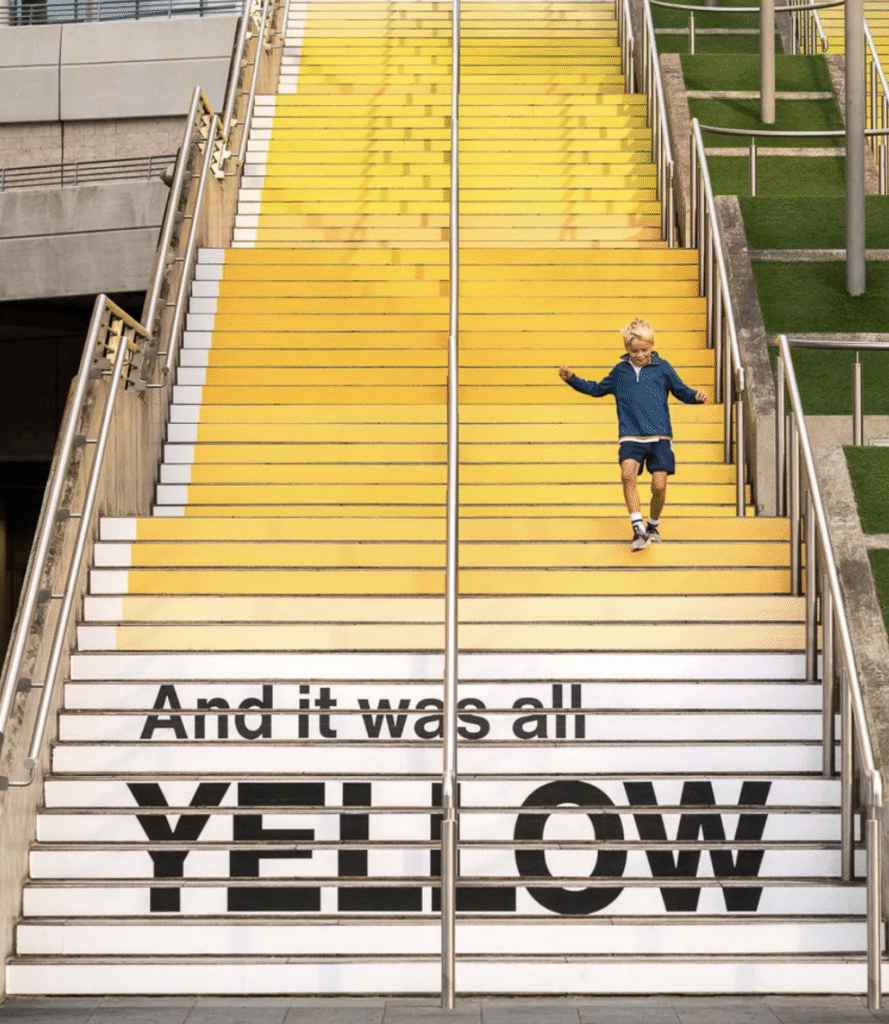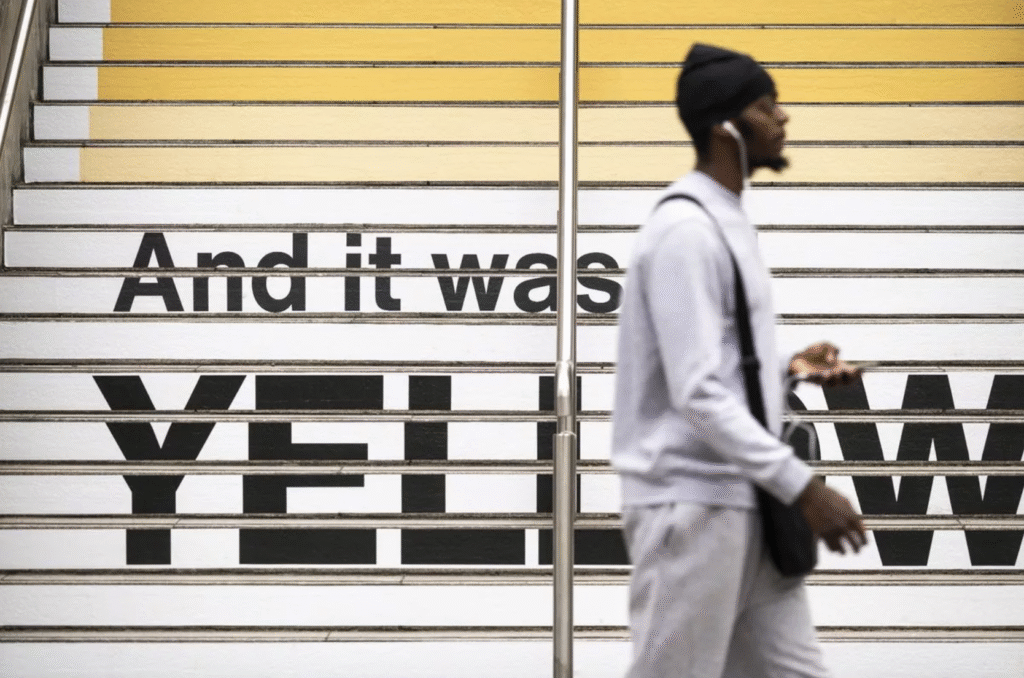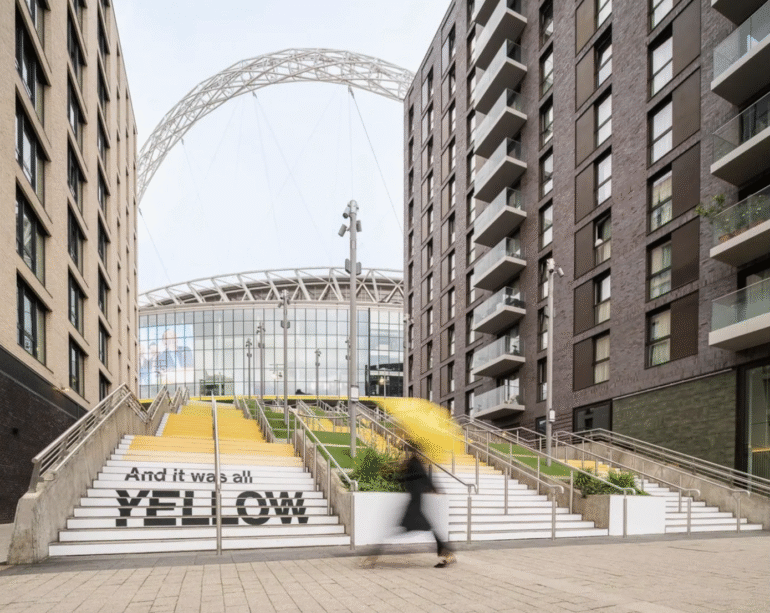Claudio Giambrone–Wembley Park’s Head of Marketing and Cultural Programming–and Pantone Creative Director Jane Boddy, talk to Culturalee about an innovative new public art installation at Wembley Park. Yellow 25 celebrates the 25th anniversary of Coldplay’s seminal record Yellow and marks the start of the band’s UK tour.

Claudio Giambrone, Head of Marketing and Cultural Programming Wembley Park
Can you tell us how the idea for Yellow 25 came about?
Last year we honoured Taylor Swift with the Swiftie Steps, which went viral. After that we created tributes to Lana Del Rey and Oasis, and now we are celebrating Coldplay in the same way. For us it is about extending the fun beyond the stadium walls and enriching the welcome across the whole neighbourhood. It also means fans and visitors who do not have a ticket can still feel part of the experience. This year it gained even more meaning when we realised it was the 25th anniversary of Yellow, the song that first launched the band back in June 2000.
Did you and your team at Pantone collaborate directly with Coldplay?
We worked with Pantone to shape the concept and stayed in regular contact with Coldplay’s management. They were generous and supportive. We led on the creative direction but always kept them informed, which made the whole process feel collaborative.
What was the production and installation process like?
The idea was strong from the start and Pantone were the right partner to bring it to life. The real challenge was technical. We had to make sure the material we chose for the install could hold all 58 shades of yellow and still reflect the richness of the original colours once printed. On top of that we had to time everything carefully around the weather and major event days. In the end the team worked overnight to make sure the Steps were ready for launch. Something that looks simple to the eye can takes a lot of effort behind the scenes.
How did Coldplay react when they first saw Yellow 25?
Their team were enthusiastic about Wembley Park partnering with Pantone. What amazed me was also the fan reaction. We were really pleased to see how soon the photos of the artwork got shared across the world so enthusiastically. It was heartwarming to see people connect with it in that way. I am also proud that London’s City Hall backed the project. Justine Simons, the Deputy Mayor for Culture, gave us a public quote. For me that showed how this piece resonated beyond Coldplay, reflecting London’s openness to bold ideas and its willingness to celebrate music and live events through art on a big scale.
What do you hope fans and visitors feel as they walk the steps?
The Spanish Steps have always been more utilitarian than architectural, built to move people between the stadium and the arena. Through projects like this they have taken on a new life. People now come to see them in their own right, as they did with the Swiftie Steps last year. That is the strength of the Wembley Park art trail. It transforms everyday parts of the neighbourhood into places people pause to enjoy. With Yellow 25 my hope is that people feel joy and optimism when they walk the steps. It is art that belongs to everyone, not only those with a ticket to a gig.

Jane Boddy, Creative Director, Pantone
Can you tell us how the idea for Yellow 25 came about? Was it initiated by Pantone, Wembley Park, or perhaps Coldplay themselves?
I remember seeing Coldplay perform Yellow when it first came out, and what struck me most was the depth of emotion behind it. That sense of feeling became the starting point for my project. I wanted to translate the shifts in the music into shifts in yellow, carefully mapping the song’s journey through different levels of saturation and brightness.
The installation transforms 58 steps into a visual journey–how did your team go about matching each step’s shade of yellow to reflect the emotional and melodic progression of the song Yellow? Was there a creative methodology or color theory that guided those decisions?
At the beginning, the yellows are muted and pale, soft like first light, reflecting the tentative and vulnerable opening of the track. As the verses unfold, the tones become brighter and more defined, echoing the song’s growing emotional clarity. The chorus bursts into rich, saturated golds, glowing, immersive and full of intensity, capturing the raw sincerity at the heart of the song.
The bridge rises to peak brightness, almost electric, a dazzling yellow that conveys the emotional climax where the music feels too powerful to contain. From there, the tones ease back into steady, glowing hues, carrying warmth and continuity as the energy begins to settle. The outro returns to gentler shades, but with new resonance, a golden haze that feels resolved and content. By mapping these tonal shifts, I created a layered immersive journey, a spectrum of yellow that mirrors the song’s emotional arc.
There is an interesting relationship between colour theory and music composition. While they’re different sensory experiences, many artists and theorists have drawn connections between the two through emotion, structure, and neurological phenomena like synesthesia–when the stimulation of one sense, like hearing music, involuntarily triggers another, like seeing colours. When creating this project, did you refer to sound-to-colour synesthesia, where individuals “see” specific colours when hearing certain musical notes or keys?
I set out to merge music and colour, not by replicating synaesthesia, but by applying the principles of colour psychology. Interestingly, yellow is a colour rich in psychological associations, making it an ideal choice to map onto Coldplay’s Yellow. As the music builds and softens, the yellow transitions from muted and tentative to vivid, luminous tones, before resolving into a gentler, more optimistic hue. Yellow’s dual nature, symbolising warmth, joy and creativity while also capable of provoking tension or anxiety when intensified, shaped my choice of shades. Through this, I translated sound into feeling, using the impact of colour psychology to visualise the emotional spectrum of the song.
This installation marks both an artistic milestone and the start of Coldplay’s UK tour–what do you hope fans and visitors feel as they walk these steps, surrounded by a spectrum inspired by one of the band’s most iconic songs?
My main focus throughout the project was to create an immersive experience, capturing the essence of yellow and exploring how it connects to the song through its many shades. I wanted people to feel as though they were stepping inside the song itself, engaging with it on a deeper, sensory level. Often, yellow is imagined as a single flat tone, but it is far more layered. Lighter yellows can feel soft and uplifting, while deeper, richer shades carry a very different kind of energy. With the Steps, I wanted people to experience this full spectrum for themselves and perhaps walk away seeing colour in a more nuanced, emotional way.
Find more information about Yellow 25 and Wembley Park Art Trail here.



